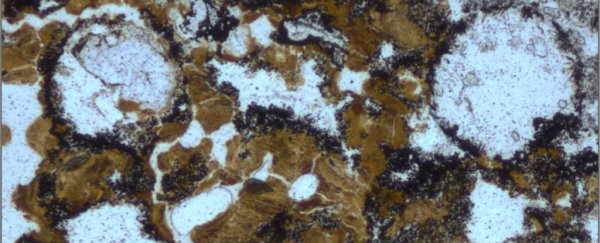Scientists have found the earliest evidence of life on land in 3.48 billion-year-old hot spring deposits in Western Australia, and it could help us solve one of the most important debates in evolutionary biology - if life on Earth arose in small, terrestrial ponds, or deep in the ocean.
These fossil signatures are so old, they push back the earliest known evidence of inhabited hot springs by some 3 billion years - something that adds weight to Charles Darwin's suspicion that the origin of life occurred in "some warm little pond".
The find not only gives us evidence of microbes being in hot springs far earlier than we'd ever imagined, it also crushes the previous record for the oldest signs of microbial life on land overall: 2.7-2.9 billion-year-old deposits in South Africa.
In doing so, the deposits give us a viable scenario for life arising on land first, rather than originating in ocean vents before migrating to the coasts.
"Our exciting findings don't just extend back the record of life living in hot springs by 3 billion years, they indicate that life was inhabiting the land much earlier than previously thought, by up to about 580 million years," says one of the team, Tara Djokic from the University of New South Wales (UNSW) in Australia.
"This may have implications for an origin of life in freshwater hot springs on land, rather than the more widely discussed idea that life developed in the ocean and adapted to land later."
Djokic and her colleagues made their discovery by analysing the incredibly well-preserved deposits of the ancient Dresser Formation in the Pilbara Craton of Western Australia.
These deposits had previously been identified as remnants of a long-lost marine environment, but new evidence suggests that we might have been looking at them wrong this whole time.
According to the new study, the Dresser Formation contains a telltale signature of land - a mineral called geyserite, which is found exclusively in the surroundings of terrestrial hot springs and geysers.
Until now, the oldest known geyserite had been identified in 400 million-year-old rocks, which means if geyserite can be confirmed in 3.48 billion-year-old deposits, we've just made them a whole lot more viable as ancient cauldrons of the planet's first life.
Not only that, but the team has identified a number of potential new 'biosignatures' in the deposits, including two different types of stromatolites - layers of sediment packed together by ancient, water-based bacterial colonies - called iron-rich domical and conical stromatolites.
They also found markings known as microbial palisade texture preserved in the stone, as well as traces of bubbles (pictured above) that could have been trapped in a sticky substance produced by microscopic organisms, which helped them retain their delicate shape for several billion years.
Together, the evidence paints a picture of an ancient volcanic caldera (or crater), filled with mineral-rich hot spring pools or vents that provided the right chemistry and warm conditions to give rise to primitive forms of life billions of years ago.
The find also bodes well for discovering signs of ancient life on other planets like Mars, which features evidence of past hot springs on its now cold and dry surface.
"This shows a diverse variety of life existed in fresh water, on land, very early in Earth's history," says one of the team, Martin Van Kranendonk, from UNSW.
"The Pilbara deposits are the same age as much of the crust of Mars, which makes hot spring deposits on the red planet an exciting target for our quest to find fossilised life there."
Of course, these kinds of ancient fossil finds are always controversial. The evidence relies heavily on interpretation, and other researchers could see those bubble markings or geyserite signatures in a different light.
But if we can find similar signs of early life in land-based ponds, scientists might just be able to pinpoint where our most ancient ancestors sprung into being - and a land-based origin of life is now looking a whole lot more promising.
The research has been published in Nature Communications.
UNSW Science is a sponsor of ScienceAlert. Find out more about their world-leading research.
